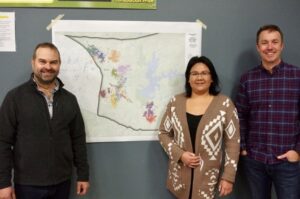
By Rick Garrick
FORT WILLIAM FIRST NATION — Fort William First Nation youth will have an opportunity to participate in a Ministry of Natural Resources (MNR) moose research project this upcoming summer in the MNR’s Wildlife Management Unit 13 in Fort William’s traditional territory.
“We can hire Indigenous youth to come and work on the project,” says Joseph Northrup, research scientist at MNR. “Any collared animal that dies, we would be trying to get out there and identify what that is, so they would be going out and doing that, but we also do a number of other things, too, so going out when wolves kill especially a big animal like a moose. We also are putting up a bunch of trail cameras in the study area to look at distribution of deer so that would be the main things they would be doing, just visiting those trail cameras, to look at mortalities for things that wolves have killed and mortality investigations of any animals that died.”
Northrup says the moose research project is looking to understand what is causing the decline in moose populations in Wildlife Management Unit 13, which is located in Fort William’s traditional territory. The MNR’s aerial moose surveys have indicated a decline in moose populations in Unit 13 since 2000.
“The project we are doing actually is a part of a bigger moose sort of research program where the idea is to better understand how we can recover the populations,” Northrup says. “There are three phases, phase one is just one that has been ongoing where we are analyzing data that already exists, aerial survey data, other types of data that we have, and then we are moving into this phase two here where we are actually implementing a big field research project so we can understand in this area in really fine detail what’s causing moose populations to decline or not recover.”
Northrup says one of their objectives with the moose research project is to identify if habitat is limiting moose.
“Do they not have enough to eat and is that why their numbers are going down?” Northrup says.
Northrup says they also want to refine their understanding of predation and harvest.
“What makes [moose] more vulnerable to predation and harvest, is it forestry roads and things like that?” Northrup says.
Northrup says they will also be looking at parasites such as brain worm and winter ticks.
“What’s causing higher prevalences or lower prevalences of those?” Northrup says.
Northrup says they will also be assessing their aerial survey methods during the moose research project.
“As a part of this project, we’re going to have a lot of collars on moose and that gives us an opportunity to try to assess our aerial survey methods and see if there’s any biases there. But more importantly, see if there’s ways to sort of expand our window,” Northrup says. “Last winter was a good example where not a lot of snow made it really difficult for us to do our aerial surveys — we need certain conditions to be able to run them.”
Northrup says depending on what they find in the first two phases of the study, they would do phase three in about five years.
“We are going to try to manipulate something, so for example, if we find out that habitat is limiting moose or something like that, we might try to do some sort of forest management that is different than what was going on and maybe that would change the habitat in some way,” Northrup says. “Or … if there is lots of brain worm, maybe more harvest of deer to reduce deer numbers so there is less brain worm or less overlap between deer and moose in the area that might be able to recover the populations. So our focus really here is just to try to implement a project that we can learn how we might do some management to recover populations of moose in the area.”
Fort William youth can reach out to Bobbi-Lee Bannon at the Fort William band office for information on participating in the moose research project at: environmentalofficer@fwfn.com.


